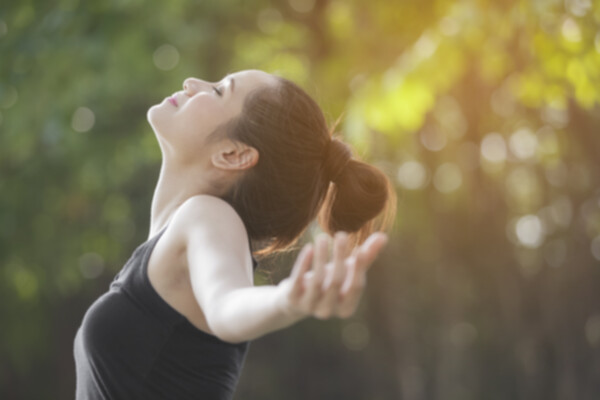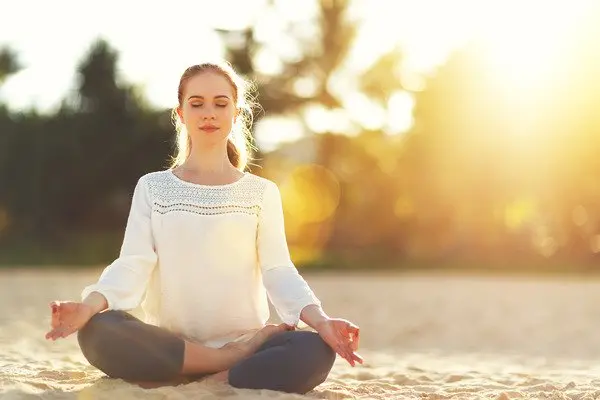Diaphragmatic breathing is a technique used to relax and combat both anxiety and depression. Here you will find the keys to do it correctly.
The breathing It is more important than at first glance we all think. So much so, that many of us do not know that we are breathing in the wrong way. Therefore, there are some breathing techniques that help us perform this act with greater naturalness and certainty. Through good breathing we can obtain great benefits both mentally and physically.
What is diaphragmatic breathing?
The diaphragmatic breathing or abdominal breathing is an effective way to combat both the stress and anxiety that our daily lives can cause us. This form of shallow breathing forces the heart to exert greater effort and does not allow the blood to be sufficiently oxygenated, which contributes to increasing states of tiredness and fatigue. So we enter a kind of loop, where anxiety leads us to breathe inappropriately and this, in turn, causes us more anxiety.
Use a diaphragmatic breathing , will make us use our lungs in a more complete and slower way. It will increase the level of CO2 in the blood, which will produce various beneficial effects for the body: decrease in heart rate, peripheral vasodilation, stimulation of gastric secretion, depression of cortical activity and a general feeling of drowsiness.
Are there different types of breathing?
Although at first glance it seems that we all breathe equally, there are many people who do not breathe correctly. In fact, ‘natural’ breathing involves our diaphragm, so when breathing we have to perform an abdominal stretch. The diaphragmatic breathing exercises They involve expanding the belly when we inhale and contracting it when we exhale. This makes our breathing more natural.
In most cases people ‘forget’ to breathe using the respiratory muscles and instead they use their chest and shoulders, which causes short, shallow breaths that end up causing them to experience more stress and anxiety. In this way, we can say that two types of respirations are identified at a general level:
- Diaphragmatic breathing or abdominal breathing: It is about deep and uniform breathing with our diaphragm. When we make a abdominal or diaphragmatic breathing , our diaphragm is activated, which allows our lungs to expand. This is how newborn babies breathe. In fact, this type of breathing also comes naturally when we are in the deepest stages of sleep.
- Thoracic (chest) breathing: This type of breathing It comes from the chest and involves taking short, quick breaths. When a person is anxious, stressed or nervous, they may not even realize that they are doing this breathing.
Diaphragmatic breathing exercises
This diaphragmatic breathing technique It consists of four exercises graduated in order of increasing difficulty. Each exercise will last between 2 and 4 minutes and will be followed by the same rest time before moving on to the next. During those minutes of rest, you will breathe more naturally and try to visualize in your mind a scene that you find especially pleasant and relaxing.
- Abdominal and ventral inspiration: The goal of this exercise is to direct the inspired air to the lower and middle part of the lungs. To do this, place one hand on top of your abdomen (above your navel) and another on top of your chest. When you inhale, you have to take the air through your nose and at the same time push your abdomen outward, so that only the hand that is located above the navel rises, but not the one on the chest. Try to make it a deep inspiration Then release the air slowly. Repeat the exercise for 2 minutes and then rest for another 2.
- Abdominal, ventral and pectoral inspiration: The objective is develop complete inspiration , in which the air also reaches the top of the lungs. To do this, he places his hands as in the previous exercise, one on the abdomen and the other on the chest. Now you will have to take a breath in two stages: filling the abdomen area with air first and then the chest area. You should notice how the hand that is placed above the navel rises first and then the other. Then release the air naturally and gently.
- Expiration: The goal now is to make a fuller and more regular breathing After a complete inhalation in two stages, as described in the previous section, to exhale, close your lips tightly so that a brief puff of air is produced, releasing the air in a slow and controlled manner. So, we inhale so that first the hand is raised above the navel, then the chest and we release the air slowly, breathing softly and long, completely emptying the lungs, as if we were inflating a balloon.
- Continuous inspiration-expiration: The objective is to achieve an adequate respiratory alternation training inspiration and expiration continuously. The difference with the previous exercise is that now the inhalation is done without marking the two beats, that is, when we take a breath, we must perceive that both hands rise at the same time because we push the abdomen and chest at the same time. The other difference is that exhalation is done more quietly and naturally, without puffing, but also softly and slowly.
The purpose of the practice is to be able to use this technique in everyday or unfavorable situations in which anxiety can be triggered. For this, it is necessary to go repeating the exercises modifying the conditions of practice: eyes open, standing, walking, with noise, other people…etc. It is important to graduate the practice in order of increasing difficulty.

Benefits of diaphragmatic breathing
There are many benefits that it can bring us breathe with the diaphragm In this way, performing diaphragmatic breathing exercises can give us many advantages for our daily lives.
- Helps us relax: This costal breathing It is a very effective aid to relax as it reduces the harmful effects of the stress-generating hormone in the body.
- Reduces heart rate and blood pressure: Through the diaphragmatic exercises Both the pressure in the arteries and the heart rate in our heart are reduced. In this way, it effectively helps reduce tension in the body as well as the prejudices that both stress and anxiety can generate.
- Reduces symptoms of post-traumatic stress disorder (PTSD): Through the exercises to relax the diaphragm People who have suffered from post-traumatic stress disorder can reduce the most common symptoms of this disease.
- Improves the ability to tolerate intense exercise: Through this type of breathing you can improve resistance to physical exercise So much so that athletes can benefit in various ways from diaphragmatic breathing.
- Increases energy: With the diaphragm exercises you may experience an increase in energy. For this reason, learning to breathe this way can reduce your fatigue and improve your productivity.
- Reduction of stress and anxiety: Clearly, one of the best benefits of these diaphragmatic breathing exercises Thanks to them you will be able to enjoy the present more and stop being overwhelmed by some situations that are out of your control. This is because through breathing we can become more aware of the present and our state.
- Improves the immune system : This diaphragmatic breathing It allows the immune system to function at its maximum capacity. This translates into suffering less illnesses, both mental and physical.

How does diaphragmatic breathing help with anxiety?
The anxiety It is accompanied by certain physical symptoms such as tachycardia, sweating, difficulty breathing, muscle tension, dry mouth, feeling dizzy, etc. But when the intensity of anxiety skyrockets, so do each of its symptoms. Applying psychophysiological techniques, such as diaphragmatic breathing, will allow us to reduce the intensity of these symptoms.
Once we have managed to lower the level of activation of the organism, we will be in a better position to think in a more reflective and adaptive way, which in turn will allow us to successfully face antigen stimuli. Therefore, reducing the degree of physiological activation is the first step in the process of anxiety control. To do this, we can use two techniques: diaphragmatic breathing and relaxation. That is why these breathing exercises together with psychological therapy allow us to face all the prejudices of anxiety.
Breathing techniques to calm anxiety and stress
Besides breathing exercises As we have shown you at the beginning, there are techniques that are more focused on treating stress or anxiety through breathing. Among the most recommended, we find the following:
- Breathing through alternate nostrils: This breathing technique It involves blocking one nostril while breathing through the other, alternating between the two nostrils in a regular pattern. This type of breathing is best practiced in a sitting position to maintain body posture.
- Belly breathing: Perform this breathing exercise It will help you reduce both stress and anxiety. To do this, you should try to fill your belly with air when you inhale and release it little by little when you exhale.
- Box breathing: The key to doing this type of abdominal breathing It is to exhale for a count of four, keep your lungs empty while you count to four again, inhale for a count of four and keep the air in your lungs while you count again to four.
- 4-7-8 Breathing: This breathing technique It acts as a natural tranquilizer for our nervous system. The first thing will be to inhale through the nose, mentally counting to four. Then you will have to hold your breath while counting to seven and finally, you will have to exhale through your mouth for a count of eight.
These are some of the diaphragmatic breathing exercises that will help you calm the anxiety and stress accumulated during everyday life. But, if your breathing is always chest-like, you may have a disorder that should be treated with a mental health professional.









